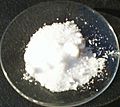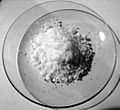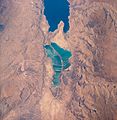Bromine facts for kids
Bromine (Br) is a chemical element. Think of it as one of the basic building blocks of everything around us. Its atomic number is 35, which means it has 35 protons in its center. Its atomic weight is about 80. Bromine is part of a special group of elements called halogens, found in Group 7 of the periodic table. It's also diatomic, meaning that two bromine atoms always stick together to form a molecule in any sample of bromine.
Contents
What is Bromine like?
Physical properties
Bromine is a unique element because it's a red-brown liquid at room temperature. This is quite rare! Only bromine and mercury are liquids when it's not too hot or cold. It can easily turn into a gas, creating brown fumes that are not good to breathe. It also has a very strong, unpleasant smell, which is why its name means "stench of he-goats." If you put bromine under extreme pressure, it can even turn into a metal!
Bromine has two main types of atoms that are stable, called isotopes: 79Br and 81Br. There are also about 29 other types that are radioactive.
Bromine freezes at a very cold temperature, around −7.2°C (19°F). It boils and turns into a gas at 58.8°C (137.8°F).
Chemical properties
Bromine is quite reactive. This means it likes to combine with other elements. It's more reactive than iodine but less reactive than chlorine. Bromine reacts with both metals and nonmetals. For example, Phosphorus and aluminum react very strongly with bromine.
Just like chlorine, bromine can also bleach things. It reacts better when there is light. It dissolves a little bit in water. If you put it in hot water, it changes into hydrobromic acid and hypobromous acid. Bromine can also form many compounds with other substances, like sodium to make sodium bromide.
Bromine compounds
Bromine can form compounds in different ways, which chemists call "oxidation states." The most common way is called –1, where it forms bromides. Bromides are usually not very reactive. They are colorless solids that dissolve easily in water. Some bromides, called covalent bromides, can be liquids or gases.
Other bromine compounds are strong oxidizing agents, meaning they can take electrons from other substances.
- Compounds in the +1 state are called hypobromites, but they are not very stable.
- In the +3 state, you find bromites.
- Bromine dioxide is a common compound in the +4 state.
- In the +5 state, there are bromates. These are more common than most other bromine compounds, except for bromides. Bromates are strong oxidizers and are sometimes added to flour.
- Finally, in the +7 state, there are perbromates, but these are very unstable.
Where is Bromine found?
You can find bromine as bromide in the ocean and in salty water pools, called brine pools. The Dead Sea is especially rich in bromide. Unlike its relatives chlorine and iodine, bromine is not an important part of our body.
How is Bromine made?
Bromine is usually made by bubbling chlorine gas through a solution that contains a bromide. In this process, the bromide changes into bromine, and the chlorine changes into chloride.
What is Bromine used for?
Bromine is mainly used to make organobromine compounds. These are organic compounds that contain bromine. Many organobromines are used to put out fires. In the past, some were added to gasoline, and others were used as pesticides to kill pests. Some inorganic bromides were used to help people relax. Bromine can also be used as a disinfectant to kill germs. Silver bromide is an important chemical used in film photography.
Is Bromine safe?
Bromine is a dangerous substance. It is toxic and corrosive to skin, meaning it can cause burns. Breathing in bromine gas can also irritate your lungs. Bromine can react very strongly and dangerously with many other substances.
| Periodic table | |||||||||||||||||||||||||||||||||||||||||
|---|---|---|---|---|---|---|---|---|---|---|---|---|---|---|---|---|---|---|---|---|---|---|---|---|---|---|---|---|---|---|---|---|---|---|---|---|---|---|---|---|---|
| H | He | ||||||||||||||||||||||||||||||||||||||||
| Li | Be | B | C | N | O | F | Ne | ||||||||||||||||||||||||||||||||||
| Na | Mg | Al | Si | P | S | Cl | Ar | ||||||||||||||||||||||||||||||||||
| K | Ca | Sc | Ti | V | Cr | Mn | Fe | Co | Ni | Cu | Zn | Ga | Ge | As | Se | Br | Kr | ||||||||||||||||||||||||
| Rb | Sr | Y | Zr | Nb | Mo | Tc | Ru | Rh | Pd | Ag | Cd | In | Sn | Sb | Te | I | Xe | ||||||||||||||||||||||||
| Cs | Ba | La | Ce | Pr | Nd | Pm | Sm | Eu | Gd | Tb | Dy | Ho | Er | Tm | Yb | Lu | Hf | Ta | W | Re | Os | Ir | Pt | Au | Hg | Tl | Pb | Bi | Po | At | Rn | ||||||||||
| Fr | Ra | Ac | Th | Pa | U | Np | Pu | Am | Cm | Bk | Cf | Es | Fm | Md | No | Lr | Rf | Db | Sg | Bh | Hs | Mt | Ds | Rg | Cn | Uut | Fl | Uup | Lv | Uus | Uuo | ||||||||||
|
|||||||||||||||||||||||||||||||||||||||||
Images for kids
-
Antoine Balard, one of the scientists who discovered bromine
-
Silver bromide (AgBr)
See also
 In Spanish: Bromo para niños
In Spanish: Bromo para niños







